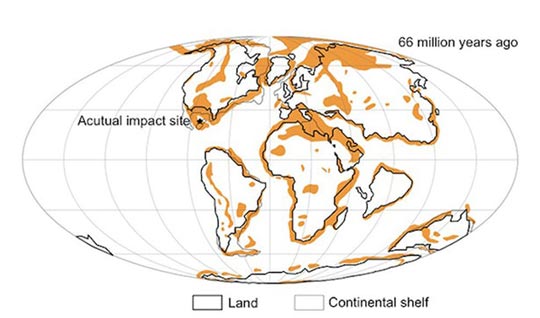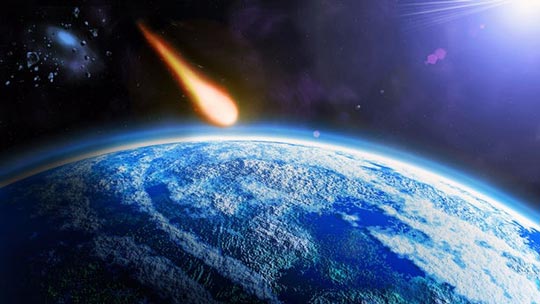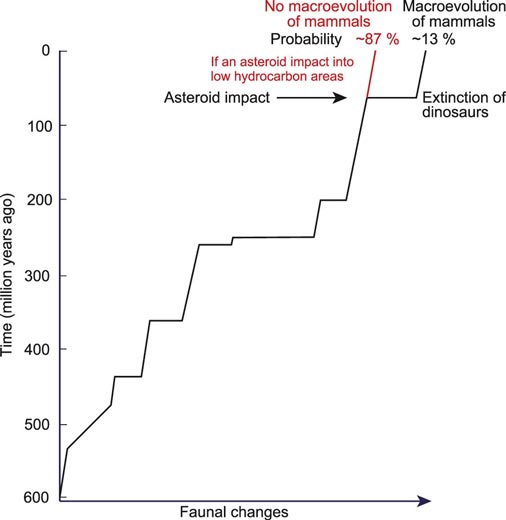Chicxulub Impact – A Really Bad Place to Hit
Chicxulub Impact – The Big Freeze
For life on Earth, the impact event that marked the end of the Mesozoic Era was made many times worse as the extra-terrestrial object caused the release of climate-active gases. As if the devastation was not bad enough, the high-velocity impact caused the release of huge quantities of sulphur and carbon dioxide into the atmosphere triggering a dramatic world-wide cooling and exacerbating the effect of this event. No wonder then, that around 70% of all terrestrial life died out.
Two scientific papers report on the consequences of this catastrophe. In the first, the effect of gases released into the atmosphere from the sedimentary rocks that were hit are modelled and in the second paper, scientists look at just how unfortunate the dinosaurs were. If the extra-terrestrial object had hit virtually anywhere else on Earth, the consequences for Cretaceous life would not have been so severe.
In simple terms, the dinosaurs were very unlucky, there was only a 13% chance of a mass extinction event occurring 66 million years ago when the object from space hit.
An Extra-terrestrial Object Hurtles Towards Earth 66 Million Years Ago
Picture credit: Deposit photos/Paul Paladin
A Global Effect
Writing in the journal “Geophysical Research Letters”, the authors of the first scientific paper report that the impact in the shallow sea of the Gulf of Mexico may have resulted in the expulsion of more than 300 billion tonnes of sulphur into the atmosphere. In addition, the rocks that the object hit also released vast quantities of carbon dioxide, somewhere around 400 billion tonnes of CO2. Some of the sulphur may have combined with water vapour to form sulphuric acid, this would have fallen back to Earth in the form of acid rain, further damaging plant life and upsetting food chains.
However, much of the gas would have remained high up in the atmosphere and behaved like aerosols, changing the amount of solar irradiation reaching the ground which led to surface temperatures plummeting.
The global effect was freezing temperatures for several years, a nuclear winter. The research team which includes scientists from the Imperial College London and Potsdam University, conclude that ocean temperatures could have been affected for hundreds of years. The abrupt climate change may explain why so many species become extinct.
The end-Cretaceous mass extinction event saw entire groups of animals and plants die out including the non-avian dinosaurs, the Pterosauria, several types of marine reptiles, as well as cephalopods such as the ammonites. In addition, there were major losses amongst brachiopods, bivalves, sea urchins and many different types of marine plankton also perished. Although, in comparison, groups such as the flowering plants (Angiosperms), amphibians, mammals and fishes were less affected, there were still extinctions.
Hitting the Earth in a very Bad Place
Plummeting temperatures and a sustained period of intense cold would have made survival for the likes of the Dinosauria, extremely difficult. Such a dramatic climate downturn would have devastated ecosystems, leaving animals like the non-avian dinosaurs and flying reptiles doomed. However, in a second paper published in the journal “Scientific Reports”, scientists from Tohoku University and the Meteorological Research Institute, Tsukuba (both in Japan), state that life on Earth 66 million years ago, was just unlucky.
According to the calculations of these scientists, there was only a thirteen percent chance of the mass extinction event that wiped out the dinosaurs. If the extra-terrestrial object had hit almost anywhere else, the consequences would not have been so severe and the Dinosauria et al might just have survived to the present day.
Examining the Consequences of the Yucatan Peninsula Impact

Picture credit: Kunio Kaiho (Tohoku University)
Climate Change Resulting from the Chicxulub Impact
The Japan-based researchers postulated that the severity of the climate change would vary depending on where the extra-terrestrial body hit. Areas with higher levels of sedimentary organic material would throw more soot into the upper parts of the atmosphere. More hydrocarbons present would result in greater releases of CO2. Those areas with sulphur-rich rocks would have released more sulphur. The team conclude that the effects of the impact were much more dramatic because the impact was in the Gulf of Mexico. To test their hypothesis, a series of impact scenarios were run using global climate models to assess changes in temperature.
When the Yucatan Peninsula Cretaceous geology was examined, the team concluded that the hydro-carbon rich strata would have thrown debris into the upper atmosphere that resulted in a drop of global temperature by an average of 8 to 11 degrees Celsius. On land, the temperature drop could have been as excessive as a fall of 17 degrees Celsius. The oceans did not fare much better, with average temperature drops of between 5 and 7 degrees Celsius at depths of up to fifty metres.
Putting this into context, our world is faced with global climate warming. The Paris Agreement, now ratified by 169 countries, has a central aim to keep the global temperature rise this century to below 2 degrees Celsius above pre-industrial levels and to pursue efforts to limit the temperature increase even further to 1.5 degrees Celsius.
Studying the Rocks of the Yucatan Peninsula
The researchers looked at how widespread the sort of rocks found in the Yucatan Peninsula in the Cretaceous, were. They found that these types of rocks were mostly associated with marine coastal margins. The shallow seas permitted the concentration of algae which could deposit more organic matter into the sediments. These areas covered just thirteen percent of the Earth’s surface.
Had the asteroid struck somewhere in the other eighty-seven percent of the planet, then, although the impact event would have been catastrophic, it might not have been as bad as it was. The researchers even go as far as to state that some species of dinosaurs may have persisted beyond the Cretaceous. The Mammalia would not have had the chance to radiate and therefore the primates, including humans, might not have evolved at all.
Changes in Fauna over the Phanerozoic Based on Extinction Events
The graph above shows Phanerozoic faunal changes with approximately 13% probability following the Chicxulub asteroid impact. Changes in fauna are based on extinction rates. A consequence of the end Cretaceous extinction event was the demise of the Dinosauria and the rise of mammals.
Sometimes it can come down to serendipity.



